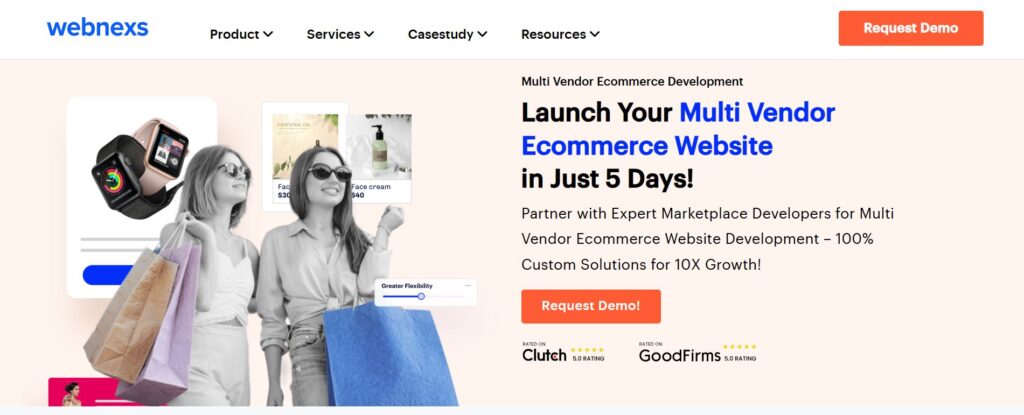59% of consumers prefer buying from online marketplaces.
Want to learn more about online marketplaces but are unsure where to begin? We’ll go over the different types of marketplaces you should be aware of in this extensive tutorial.
Understanding these various marketplace types is essential for success in the digital sphere, regardless of your level of experience as a business owner or as an aspiring entrepreneur. We’ll examine each kind, from peer-to-peer marketplaces to business-to-business platforms, emphasizing their distinct qualities and advantages.
The global online marketplace market is projected to reach $40.1 trillion by 2025, growing at a CAGR of 14.5%.

Key Takeaways on Types of Online Marketplaces
- Online marketplaces are varied in their types and models, and based on the target audience, the most viable option will yield greater results.
- The online marketplaces are more than a shopping platform. They provide additional information to help in purchase decision-making by collecting reviews and ratings from customers.
- The scope of products has expanded over the years to cover a variety of industries. With each industry having its leaders, convenience has increased to a greater extent.
- A consultation with the Webnexs team would aid in developing a construct for your ecommerce business ideation.
What is an Online Marketplace? List Some Examples
Online marketplace is a platform in the digital space that facilitates the buying and selling of products listed on the ecommerce platform by the vendors and the customers and this is irrespective of the types of marketplaces. The platforms not only fulfill orders but assist customers by displaying product reviews, ratings, and detailed product descriptions. The scope of industry that they operate in is not limited. We will explore them in the following section.
For an online marketplace the ideal Gross Profit margin is approximately 45%.
There are numerous types of online marketplaces across the globe, but only some have succeeded in acquiring a major share of their respective industries. Here’s a list of the top 3 players in each industry:
1. Multi-Product Category
- Amazon
- eBay
- Walmart Marketplace
Average Revenue Per User (ARPU) in the US is approximately $4,500, which indicates revenue potential for multi-product category ecommerce platforms.
2. Fashion & Apparel
- Zappos
- Farfetch
- Poshmark
The global fashion ecommerce market is expected to grow at a compound annual growth rate (CAGR) of 8.8% between 2024 and 2030.
3. Electronics & Gadgets
- Best Buy Marketplace
- Newegg
- B&H Photo Video
The global electronics ecommerce market is expected to grow at a CAGR of 12.3% from 2020 to 2027.
4. Home & Furniture
- Wayfair
- Houzz
- Overstock
The global home and furniture ecommerce market is expected to reach USD 744.41 billion by 2027, growing at a CAGR of 14.1%.
5. Grocery & Food Delivery
- Instacart
- Amazon Fresh
- Walmart Grocery
The global food ecommerce market is expected to grow at a CAGR of 16.35% from 2025 to 2033, reaching $1,191.03 billion by 2033.
6. Handmade & Unique Products
- Etsy
- Zazzle
- Redbubble
Market is expected to reach $983.12 billion by 2030, growing at a CAGR of 4.9% from 2025 to 2030.
7. Health & Beauty
- Sephora
- Ulta Beauty
- iHerb
Market is expected to reach $426.6 billion by 2027, indicating a compound annual growth rate (CAGR) of approximately 10%.
8. Automotive & Parts
- Carvana
- AutoTrader
- RockAuto
Market is projected to grow to $343.13 billion by 2032, which is a compound annual growth rate (CAGR) of 16.6%.
According to Coresight Research, approximately 7,327 retail stores closed in 2024. It is expected that around 15,000 stores could close in 2025. This is due to the ecommerce dominance that is surging, highlighting the immense potential for new entrants in operating an online store.
Online customers prefer online marketplace to traditional ecommerce websites due to its genuine convenience. The number of multi-vendor marketplaces has increased within the past ten years. Additionally, the types of online marketplaces have also gained prominence.
A department store, for instance, would resemble today’s internet marketplace, which is sometimes referred to as “Department Stores 2.0.” The online marketplace does not have to own the inventory before making it accessible to customers under this approach, which allows users to access merchants’ goods electronically.
Customers have access to all of the products that suppliers sell, and the marketplace’s website or app displays real-time product information. Because of this, different types of marketplaces that are internet based are far more comprehensive platforms than any one online store.
In general, customers don’t want to use apps from certain stores. In actuality, consumers are more likely to download an app that offers a greater variety of goods and options than one that is exclusive to a certain seller or merchant. This is why marketplace types that group multiple vendors have more web traffic and conversions.
Types of Online Marketplaces Based on Business Model
1. Business-to-Consumer (B2C)
This is the most common one in the types of online marketplaces. Businesses directly sell to the end users. A wide range of product categories are available to choose from. To reach the customers, mass marketing is done through social media, advertisements, and email marketing, commonly. Additionally, horizontal and vertical marketplaces in ecommerce are common in this type.
This model is projected to reach $6.43 trillion by 2026, growing at a compound annual growth rate (CAGR) of 9.8%.
Opportunities for new entrants:
- Social commerce enables businesses to sell directly on platforms like TikTok, Instagram, and Facebook.
- Direct-to-consumer (DTC) brands focus on creating unique, customer-centric products while bypassing middlemen.
2. Business-to-Business (B2B)
Here too, transactions happen but the parties involved are different. Businesses such as manufacturers, wholesalers, and retailers seek to fulfill their business requirements. The products listed in this platform are mostly industrial. There are horizontal and vertical marketplaces in ecommerce as well.
It is predicted to grow at a compound annual growth rate (CAGR) of 18.2% from 2024 to 2030.
Opportunities for new entrants:
- Niche marketplaces cater to specific industries such as industrial equipment and wholesale fashion.
- AI and automation enhance procurement, pricing, and logistics through intelligent solutions.
3. Consumer-to-Consumer (C2C)
This is a type of marketplace where the parties involved are customers themselves, but they become sellers and buyers. They most often sell second-hand goods, but new products are also listed. Some platforms also provide negotiations or even auction-style bidding.
It is expected to grow to $3.1 trillion by 2025 and $5.98 trillion by 2028. By 2032 it may exceed $11.2 trillion.
Opportunities for new entrants:
- Resale and secondhand marketplaces capitalize on the growing demand for pre-owned fashion, electronics, and furniture.
- Blockchain and secure payments enhance trust and transaction security in peer-to-peer sales.
Seizing the right opportunity requires penetrating the market with a robust ecommerce platform that provides a compelling experience for the users to outperform the competitors. By requesting a free demo, an ideation of the platform can be formed.
Types of Online Ecommerce Marketplaces Based on Industry
1. Retail & Consumer Goods Marketplaces
- Examples: Amazon, eBay, Walmart
- Specialization: From electronics to apparel, serving both B2C and B2B buyers.
2. Fashion & Apparel Marketplaces
- Examples: Zalando, ASOS, Farfetch
- Specialization: Clothing, accessories, and footwear.
3. Grocery & Food Delivery Marketplaces
- Examples: Instacart, FreshDirect, BigBasket
- Specialization: Groceries, fresh produce, and ready-to-eat meals.
4. Electronics Marketplaces
- Examples: Newegg, Best Buy, B&H
- Description: Tech products, gadgets, and accessories.
5. Handmade & Crafts Marketplaces
- Examples: Etsy, Zibbet, Handmade at Amazon
- Description: Handmade, or vintage products.
6. Automotive Marketplaces
- Examples: Cars.com, Carvana, AutoTrader
- Description: Auto parts and accessories.
7. Industrial & Manufacturing Marketplaces
- Examples: Alibaba, ThomasNet, IndiaMART
- Description: B2B marketplaces facilitating the trade of raw materials, machinery, and industrial equipment.
8. Healthcare & Medical Marketplaces
- Examples: Medline, McKesson, HealthTap
- Description: Medical supplies, pharmaceuticals, and healthcare services.
9. Real Estate Marketplaces
- Examples: Zillow, Realtor.com, Redfin
- Description: Property buying, renting, and selling.
10. Home & Furniture Marketplaces
- Examples: Wayfair, Houzz, Overstock
- Description: Home decor, furniture, and interior design products.
11. Education & eLearning Marketplaces
- Examples: Udemy, Coursera, Teachable
- Description: Online courses, tutoring, and educational materials.
12. Services Marketplaces
- Examples: Fiverr, Upwork, TaskRabbit
- Description: Digital and physical services.
13. Travel & Hospitality Marketplaces
- Examples: Airbnb, Booking.com, Expedia
- Description: Hotel bookings, vacation rentals, and travel-related services.
14. Luxury Goods Marketplaces
- Examples: 1stDibs, The RealReal, Chrono24
- Description: High-end fashion, jewelry, art, and collectibles.
Read More: Best Online Marketplace Platforms For Your Ecommerce
Types Of Online Marketplaces Based on Scope and Specialization
1. Vertical Marketplaces

Products from many suppliers are sold in a vertical marketplace, but they are all in the same category. A website like abc.com, for instance, would be regarded as a vertical marketplace if it solely offered jewelry and related goods for sale online.
The website might also be useful by guaranteeing product legitimacy, which is important for expensive goods like jewels. Each piece of jewelry featured on abc.com is given a unique identification number, and its authenticity is confirmed before it is made available to customers to gain trust.
Global vertical market is projected to grow at a CAGR of 12.9%, reaching USD 512.75 billion by 2031.
Opportunities for new entrants:
- Specialized product offerings cater to niche markets such as luxury fashion, organic food, and gaming accessories.
- Expert curation and personalization enhance the user experience through AI-driven recommendations.
2. Horizontal Marketplaces

A horizontal marketplace sells a variety of products that have a common feature, as opposed to a vertical marketplace that concentrates on a single product category. Many people think that by allowing users to buy and sell from one another at the same time, horizontal marketplaces encourage consumers to explore their interests.
Customers can also purchase from several sellers simultaneously on these platforms. It is simpler to compare options and make well-informed purchasing decisions when users can examine goods and services from multiple suppliers in a single app. This highlights the benefits of different types of online marketplaces. Offering customers a wide range of products from various kinds of shops is the main objective of a horizontal marketplace.
It is projected to grow to $8 trillion by 2027, capturing nearly 22.6% of total retail sales worldwide.
Opportunities for new entrants:
- Multi-category marketplaces allow businesses to build platforms like Amazon, offering diverse products under one roof.
- Cross-selling and upselling use data analytics to increase sales across different product categories.
3. Global Online Selling Marketplaces in Ecommerce

An online store that offers a large selection of goods is called a global marketplace. With more than 1 billion goods for sale and 150 million users, eBay is a perfect example. These products, which accounted for around $90 billion in sales this year, are about 80% new and distinctive. With global marketplaces catering to diverse product categories, this demonstrates how marketplace types can vary.
By providing customers with reasonable prices, facilitating interactive product comparisons, and making sure they believe they are getting the most out of their purchases.
Global retail ecommerce sales are projected to reach $7.4 trillion in 2025, and is expected to grow to $7.96 trillion by 2027.
Opportunities for new entrants:
- The electronics industry holds immense potential in ecommerce. By focusing on niche areas like refurbished electronic devices, gaming accessories more audience attraction can be gained due to lower competition.
- The media industry holds immense potential in ecommerce. Plus-size clothing, sustainable fashion, are some niche areas that can attract a loyal customer base.
Read More: How To Create An Online Marketplace Website In 3 Simple Steps?
Choosing the right Type of Marketplace with Webnexs

With our expertise in building online platforms, we provide professional guidance on selecting the most suitable type of online marketplace, whether it is horizontal and vertical marketplaces in ecommerce, and offer expert consultation to support the development of your ecommerce store.
We design strong and flexible ecommerce platforms tailored to business needs. Our development process is designed to be reliable, and adaptable, to ensure smooth and successful ecommerce platforms are built to meet business goals.
Wrapping up
The knowledge of a variety of ecommerce platforms in a variety of industries will help in navigating through the pros and cons of each, along with the growth potential to arrive at the type of online marketplace that works with the highest viability for the business goals.
The market type should align with the business goals. A misalignment will lead to a poor business structure and would not yield maximum returns. Careful consideration in planning the business execution will result in appropriate results and increase the growth potential.
Given the immense potential in the ecommerce space, you will need to explore the industry with your business goals. Next to that, a detailed plan of your online marketplace needs to be prepared. A demo with our team can become the first step in setting up a solid plan for your business.





